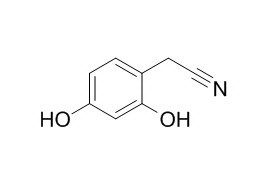(2,4-Dihydroxyphenyl)acetonitrile
(2,4-Dihydroxyphenyl)acetonitrile is a natural product from Diploclisia glaucescens.
Inquire / Order:
manager@chemfaces.com
Technical Inquiries:
service@chemfaces.com
Tel:
+86-27-84237783
Fax:
+86-27-84254680
Address:
1 Building, No. 83, CheCheng Rd., Wuhan Economic and Technological Development Zone, Wuhan, Hubei 430056, PRC
Providing storage is as stated on the product vial and the vial is kept tightly sealed, the product can be stored for up to
24 months(2-8C).
Wherever possible, you should prepare and use solutions on the same day. However, if you need to make up stock solutions in advance, we recommend that you store the solution as aliquots in tightly sealed vials at -20C. Generally, these will be useable for up to two weeks. Before use, and prior to opening the vial we recommend that you allow your product to equilibrate to room temperature for at least 1 hour.
Need more advice on solubility, usage and handling? Please email to: service@chemfaces.com
The packaging of the product may have turned upside down during transportation, resulting in the natural compounds adhering to the neck or cap of the vial. take the vial out of its packaging and gently shake to let the compounds fall to the bottom of the vial. for liquid products, centrifuge at 200-500 RPM to gather the liquid at the bottom of the vial. try to avoid loss or contamination during handling.
Fundam. Toxicol. Sci.2024, 11(4):197-204
Enzyme and Microbial Technology2022, 110002.
PLoS One.2018, 13(3):e0193386
British Jou. Med.&Med. Research2014, 1802-1811
Biomolecules.2019, 9(11):E696
Saf Health Work.2019, 10(2):196-204
J Appl Toxicol.2024, jat.4615.
Plant Cell Tiss Org2020, 1-16
Heliyon.2022, e12337.
J Neuroinflammation.2020, 17(1):75.
Related and Featured Products
Oecologia, 1977 , 30 (1) :55-61.
The allelopathic potential of Erica scoparia L.[Reference:
WebLink]
The phytochemical action of Erica scoparia L. upon its environment was studied.
METHODS AND RESULTS:
The toxicity of biogenic heath products on red clover seedlings was demonstrated by biological tests. Ten phenolic hydrosoluble compounds were identified; p-Hydroxybenzoic, vanillic, syringic, caffeic, ferulic, p-coumaric, protocatechuic, genetisic, and 2-hydroxyphenyl acetic acid, as well as (2,4-Dihydroxyphenyl)acetonitrile.
CONCLUSIONS:
The suppression of herbs, especially grasses, in heathlands can be explained, at least partially, by the allelopathic effects of E. scoparia L.



